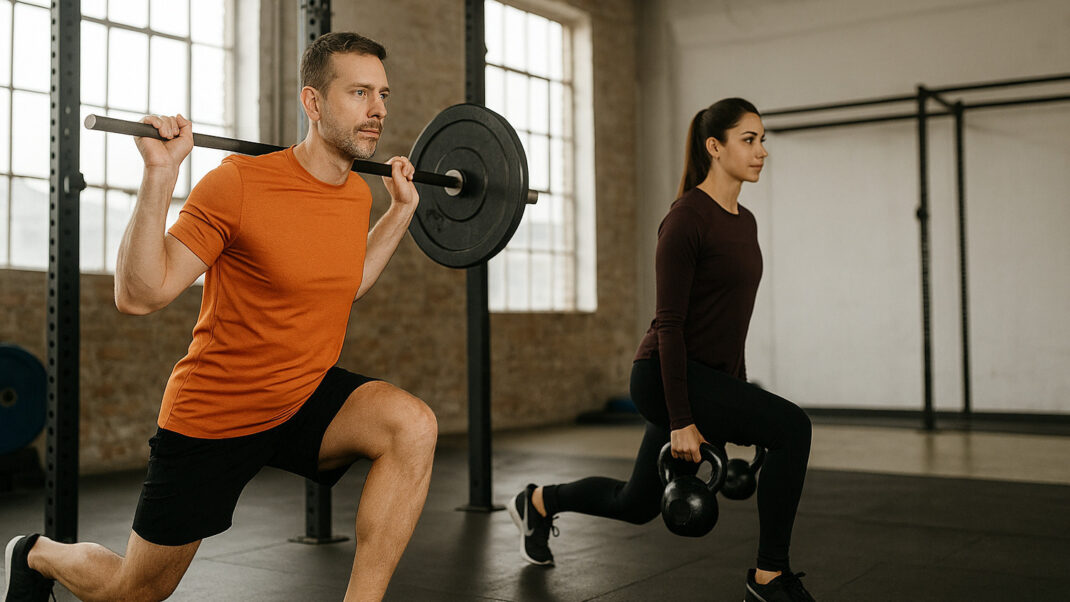High-Intensity Functional Training
Studies show that HIFT can boost exercise enjoyment and adherence.
High-intensity functional training (HIFT) is a relatively new exercise modality that emphasizes multijoint exercises that mimic everyday activity—such as pulling, lifting, locomotion—combined with aerobic and resistance training elements. HIFT can be adapted and modified for all fitness levels (Cosgrove, Crawford & Heinrich 2019; Feito et al. 2018).
What Makes HIFT Unique?
Although sometimes compared with high-intensity interval training (HIIT), perhaps due to the high-intensity nature of both training programs, HIFT and HIIT have some key differences. With HIIT, there are relatively short bursts of vigorous exercise that alternate with low- to moderate-intensity movement recovery (or rest) periods.
See also: Body-Weight HIIT Exercise
HIFT, on the other hand, incorporates a variety of functional aerobic and muscle-strengthening exercise performed at various durations that typically do not include a defined rest period. Most HIFT workouts are developed so that clients complete a specific number of repetitions in the fastest time possible or complete a group of exercises within a given time frame for as many repetitions as possible (AMRAP) (Feito et al. 2018). Rest breaks are based on a client’s fitness level and are taken as needed.
Feito et al. proposed a definition of high-intensity functional training as a “training style [or program] that incorporates functional, multimodal movements, performed at relatively high intensity, and designed to improve parameters of general physical fitness and performance.”
To further clarify: Intensity is relative to an individual’s ability; general physical fitness includes cardiovascular endurance, strength, body composition and flexibility; and performance is described as the person’s agility, speed, power and strength.
A History of High-Intensity Functional Training
HIFT began as a grassroots program that has evolved and developed to meet the specific work demands of special populations. It reflects a shift to develop physical fitness programs and physiological assessments that mimic job-related tasks as opposed to traditional fitness programming (Feito et al. 2018).
Feito et al. explain that the HIFT movement began with military personnel, firefighters and law enforcement officers who needed to train to improve their operational readiness and not solely to improve aerobic capacity or strength parameters. The authors cite research findings that show, “Among military populations, such as the U.S. Army, criticisms of the current physical training program exist, including insufficient preparation for combat and lack of training in multiple fitness domains.”
One of the first scientific published mentions of HIFT as a strategy among civilian clients appeared in Heinrich et al. (2014). In that study, the researchers compared markers of enjoyment and adherence between physically inactive individuals enrolled in a HIFT program with those in a traditional moderate-intensity aerobic and weight training program.
After 8 weeks of training, the HIFT group spent significantly less time exercising and had higher exercise enjoyment and greater intentions to continue the exercise program (Heinrich et al. 2014; Fieto et al. 2018).
In fact, 100% of the HIFT participants reported that they intended to continue, as compared with 56% of the traditional training group (Fieto et al. 2018). That alone makes HIFT a powerful tool in the retention toolbox for fit pros.
See also: Variable Resistance Training With Deadshifts and Deadlifts
Evidence-Based Physiological Benefits and Risks
Several high-intensity functional training investigations use a model that increases work capacity over time with a variety of modalities including weightlifting (deadlift, shoulder press, snatch, etc.), single-activity programs (rowing, running, cycling, etc.), and body-weight exercises (pushups, squats, lunges, etc.) (Feito et al. 2018).
Benefits
Early research studies with both men and women doing HIFT showed significant changes and improvements in
- aerobic capacity;
- muscular strength, endurance and power;
- body composition;
- brain-derived neurotrophic factor (BDNF; an important protein in making new neurons); and
- cardiometabolic health factors.
See “Evidence-Based Benefits of HIFT,” below, for more.
Risks
As to the risks of HIFT, Gianzina & Kassotaki (2019) completed a systematic review of 25 publications on the benefits and risks of HIFT. The researchers summarize the risks of HIFT include “musculoskeletal injuries occurring at different body parts, with most common being shoulder, lower back and knee injuries, and other more severe but less common injuries, such as exertional rhabdomyolysis.”
High-Intensity Functional Training Workout Program Design
HIFT programs are constantly varied to avoid boredom and training plateaus, yet balanced to address the whole body (upper to lower extremity; anterior to posterior; all planes of motion) while promoting both cardiorespiratory and muscular fitness adaptations. With the varied combination and order of aerobic and complex anaerobic exercises in HIFT workouts, it’s important to consider progressive overload principles—volume, intensity, velocity, technical difficulty—to successfully challenge, yet not overly fatigue, clients.
See “5-Day HIFT Sample Program,” below, for an example of HIFT workouts. Typically, a HIFT session is 60 minutes and includes the following components: 1) general warmup, 2) joint mobility/dynamic range-
of-motion phase, 3) task-specific warmup, 4) strength/skill phase, 5) aerobic/anaerobic conditioning phase and 6) cooldown.
When designing workouts for a group setting, it’s important to recognize and consider those clients who are most advanced and those who are inexperienced. The goal of the design is to provide enough stimulus for the experienced while also adapting the moves for novice individuals.
Components of a High-Intensity Functional Training Session
1. General warmup: Perform 3–5 minutes of light-to-moderate aerobic exercise, such as rowing, biking, walking or jogging.
2. Joint mobility/dyna-mic range-of-motion phase: Address the areas of the body that will be used most during the strength/skill phase and conditioning phase. For example, if there are back squats prescribed in the strength/skill phase, perform dynamic range-of-motion movements that address anterior and posterior hip mobility, such as the alternating Spiderman stretch, the walking quadriceps stretch and knee hugs.
3. Task-specific warmup: Perform light exercises and drills that prepare the individual for the movements being performed in the strength/skill and conditioning phases. For example, if there are power snatches in the strength phase, perform snatch drills with a dowel, then an empty barbell, progressing to the complete lift in the strength/skill phase.
4. Strength/skill phase: This is the time to spend on technique, skill and muscular fitness development for movements such as weightlifting, powerlifting or gymnastics (power snatches, back squats, or pullups/muscle ups, respectively). Traditional training principles apply in this phase: Specify a relative intensity, and set the number of repetitions and predetermined recovery periods based on the training goal, such as hypertrophy, strength, endurance or technique development.
5. Aerobic/anaerobic conditioning phase: Incorporate a mix of short sprints (<5 minutes) and longer endurance-type workouts (≥20 minutes). These may include unimodal and multimodal exercises in the same workout.
6. Cooldown: Continued movement is vital for appropriate total-body recovery. Perform 2–3 minutes of light aerobic exercise such as slow biking or walking followed by static stretching.
Adapting Workouts
Typically, the volume or time domain is set for a given HIFT workout; however, several aspects of the workout may be modified to still achieve the desired stimulus, yet decrease risk for injury, including
- total repetition volume;
- exercise variations that accommodate training experience and skill level (e.g., motor control, strength, flexibility); and
- external load of weights used by participants.
Moreover, the inclusion of prescribed recovery intervals may enhance technique and movement efficiency, as well as the relative contribution of the energy systems.
Tips for Implementing HIFT
1. Get to know your clients. What is their training background? Do they have any injuries or movement limitations? What are their training goals/needs?
2. Perform initial screenings/assessments to determine clients’ readiness to perform weighted and dynamic movements such as Olympic lifts.
3. Provide proper demonstration of all exercises used in the workout.
4. Educate your clients on the goal of the workout (e.g., strength or stamina; technique or load; time to completion; number of rounds/repetitions).
5. Pay close attention to repetitions to ensure consistency and safety. Hold your clients accountable to correct form.
Final Thoughts
The appeal of HIFT has definitely increased during the last decade. More research on HIFT is certainly on the way and will more clearly determine the potential benefits, safety precautions and appropriate modifications for all participants to enjoy.
Evidence-Based Benefits of HIFT
- improvement in VO2max and body composition and increases in BDNF (an important protein in making new neurons) (Murawska-Cialowicz, Wojna & Zuwala-Jagiello 2015)
- improvements in maximal aerobic and anaerobic power (Buckley et al. 2015)
- improvements in flexibility, power, and muscular strength and endurance (Cosgrove, Crawford & Heinrich 2019; Buckley et al. 2015)
- improvements in body composition and functional movements (Heinrich et al. 2015)
- high exercise enjoyment with intentions to continue HIFT (Heinrich et al. 2014)
HIIT Versus HIFT
5-Day HIFT Sample Program
Avoiding Injury
Column co-author Jessica Smith, MS, a USA Weightlifting Level 2 Coach, has taught HIFT for 12 years. She offers this advice to new instructors: “Always remember the factors that can increase a client’s injury risk, such as incorrect movement patterns and technique, injury history, medical conditions, fitness level and fatigue.” Ways to Monitor Workout Intensity Use percentage of heart rate maximum (using your preferred heart rate monitor) and ratings of perceived exertion.
References
Buckley, S., et al. 2015. Multimodal high-intensity interval training increases muscle function and metabolic performance in females. Applied Physiology, Nutrition, and Metabolism, 40 (11), 1157–62.
Cosgrove, S.J., Crawford, D.A., & Heinrich, K.M. 2019. Multiple fitness improvements found after 6-months of high intensity functional training, Sports, 7 (9), 203.
Feito, Y., et al. 2018. High-intensity functional training (HIFT): Definition and research implications for improved fitness. Sports, 6 (3), 76.
Gianzina, E.A., & Kassotaki, O.A. 2019. The benefits and risks of high-intensity CrossFit training. Sport Sciences for Health, 15, 21–33.
Heinrich, K.M., et al. 2014. High-intensity compared to moderate-intensity training for exercise initiation, enjoyment, adherence, and intentions: An intervention study, BMC Public Health, 14, (789).
Heinrich, K.M., et al. 2015. High-intensity functional training improves functional movement and body composition among cancer survivors: A pilot study. European Journal of Cancer Care, 24 (6), 812–17.
Murawska-Cialowicz, E., Wojna, J., & Zuwala-Jagiello, J. 2015. Crossfit training changes brain-derived neurotrophic factor and irisin levels at rest, after Wingate and progressive tests, and improves aerobic capacity and body composition of young physically active men and women. Journal of Physiology and Pharmacology, 66 (6), 811–21.
Jessica Smith, MS, CSCS
Jessica Smith, MS, CSCS, is a doctoral student in exercise science at the University of New Mexico in Albuquerque, where she works as a teaching and research assistant in the Health, Exercise and Sports Science Department. Her research interests include biomechanical and metabolic adaptations to resistance training and methodologies of program design.
Len Kravitz, PhD
Len Kravitz, PhD is a professor and program coordinator of exercise science at the University of New Mexico where he recently received the Presidential Award of Distinction and the Outstanding Teacher of the Year award. In addition to being a 2016 inductee into the National Fitness Hall of Fame, Dr. Kravitz was awarded the Fitness Educator of the Year by the American Council on Exercise. Just recently, ACSM honored him with writing the 'Paper of the Year' for the ACSM Health and Fitness Journal.





